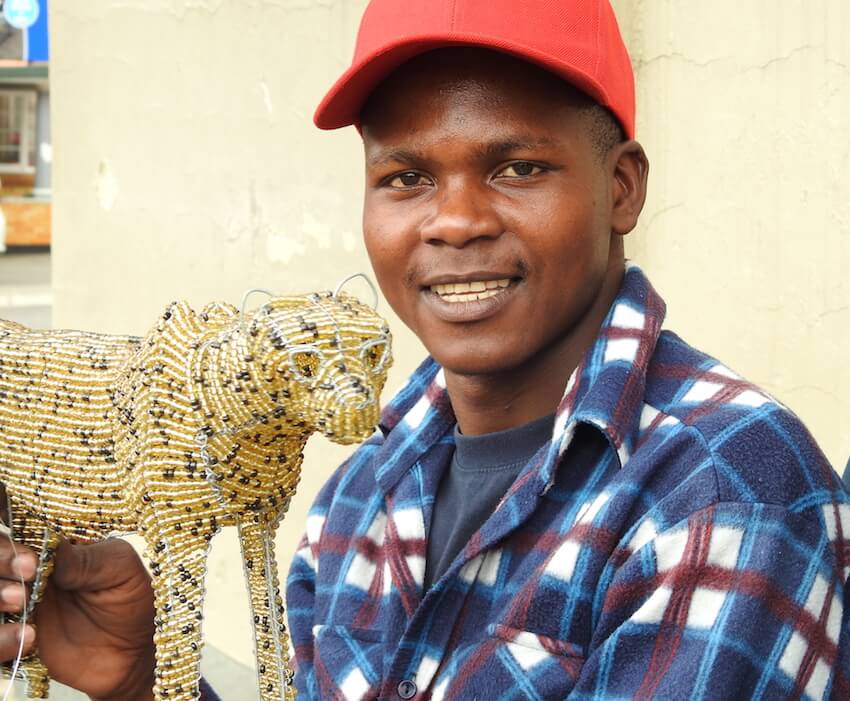 Whenever I walked to the local shops, I always stopped to pat the lion. He was a magnificent beast, about two years old and a metre tall with a gorgeous golden mane.
Whenever I walked to the local shops, I always stopped to pat the lion. He was a magnificent beast, about two years old and a metre tall with a gorgeous golden mane.
One day he was gone, and his owner Owen Chisvo gave an apologetic smile. “I sold him to a game lodge in Mpumalanga,” he said. The lion was the most amazing piece of beadwork I’d ever seen, made from tens of thousands of tiny orbs with a flowing mane created from dozens of short skeins looped around each other.
Chisvo (25) had wanted R4,000 for it, but settled for R2,000 – a pittance given the cost of the components and weeks of labour. It was damaged, he shrugs, and slightly skewed, because somebody sat on it when he wasn’t looking.
Chisvo is one of the numerous beading experts that brighten up our pavements at shopping centres and busy crossroads. If you stop for a closer look, you’ll realise that the amount and the intricacy of their work is incredible. His patch at Greenside’s Village Green shopping centre in Johannesburg is a menagerie of striped giraffes, wide-mouthed hippos, fat zebra, crested hoopoes nodding in the breeze, and a large, bright gecko climbing a tree in the centre.
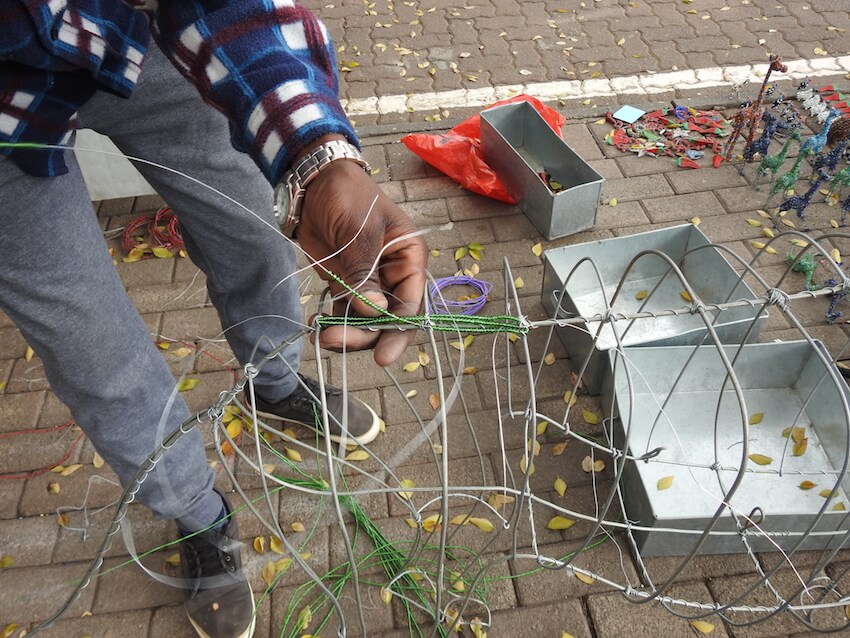 He points to a figure he calls the ‘ugly dog’ and tells me it’s four years old, looking brand new despite bad weather. “This stuff and the rain are friendly,” he smiles.
He points to a figure he calls the ‘ugly dog’ and tells me it’s four years old, looking brand new despite bad weather. “This stuff and the rain are friendly,” he smiles.
He’s such a gentleman that he offers me his battered old chair while we chat. I sit, and almost tumble onto the pavement. “Oh yes,” he says sheepishly, “I know the tactics for sitting on it now when it tries to throw me off!” Chisvo, 25, comes from Harare and moved to South Africa in 2008. “I was selling in Victoria Falls but I’d get two customers a week. Tourists have been running away from there, so I followed them here,” he says.
He older brother had learned beading at art school for two years, and passed on the skills to Chisvo. It’s a three-part process. First, he uses thick wire and fine-nosed pliers to mould the skeleton of whatever he’s creating. He twists the metal as he talks, and if I use my imagination I can see the ear of a cheetah emerging.
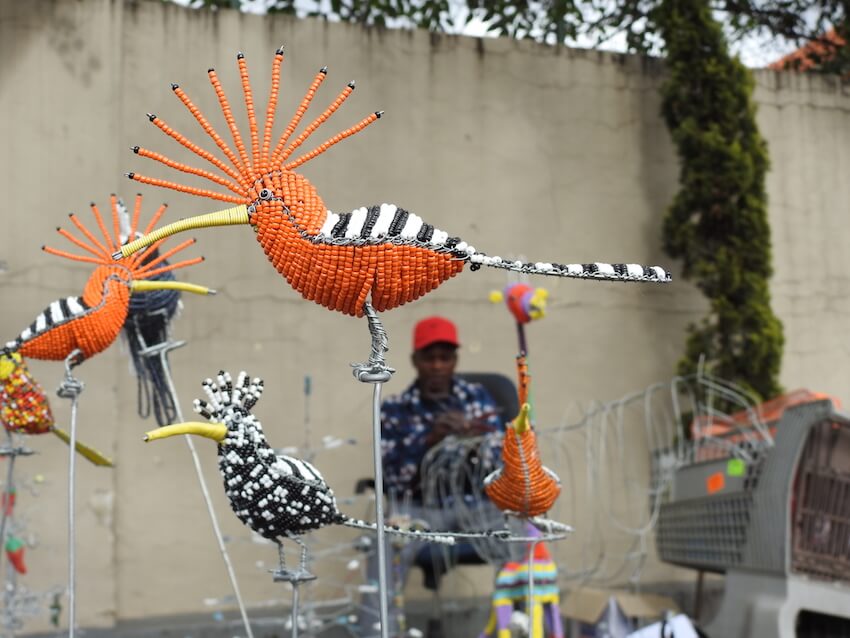 “In the beginning I was working from pictures, but now I know the structures of the animals, so when I’m planning to make something I know how to do it,” he says. “I can see the vision when I’m holding the wire, so I just bend it because the picture is in my head.”
“In the beginning I was working from pictures, but now I know the structures of the animals, so when I’m planning to make something I know how to do it,” he says. “I can see the vision when I’m holding the wire, so I just bend it because the picture is in my head.”
A large zebra will take almost a week from start to finish, with the frame alone taking a whole day. “You can’t rush with creating a good thing,” he says. The second task is to thread the beads onto long strands of 0.7mm wire. He evens up a bundle of 10 long wires and sharpens one end by rubbing them on the pavement. Then he prods their points repeatedly into a bag of beads to spear them. A shake or two jiggles them down the wire, then he pokes them around the bag again. As the skeins are completed, he twists the ends to lock the beads in place.
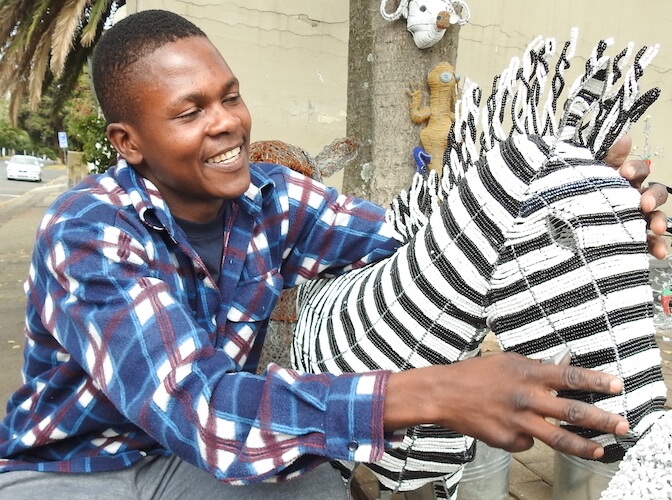 Finally each string of beads is placed onto the frame one at a time, and painstakingly tied on with fine filaments of wire every few centimetres. I’m astonished. Can’t you just place 10 skeins on the frame and tie them all on at once, I ask? He looks at me like I’ve just asked Leonardo da Vinci why he doesn’t rather use a spray gun, and shakes his head patiently.
Finally each string of beads is placed onto the frame one at a time, and painstakingly tied on with fine filaments of wire every few centimetres. I’m astonished. Can’t you just place 10 skeins on the frame and tie them all on at once, I ask? He looks at me like I’ve just asked Leonardo da Vinci why he doesn’t rather use a spray gun, and shakes his head patiently.
Chisvo is a familiar face in the car park, and several people wave or shout a greeting as they pass. “It’s busy here so it’s a good place to work,” he says. “I have regular customers and some people place orders. I like to make the things that people are running for. If they want ducks I’ll make ducks. If I see they like giraffes, I’ll make giraffes.”
He’s a savvy businessman too, tailoring his output to suit the season. In February he makes roses and flowers, and for Easter he produces rabbits. “In December it’s Christmas decorations like stars and bells and reindeers, and rhino when there’s discussions about rhinos,” he says.
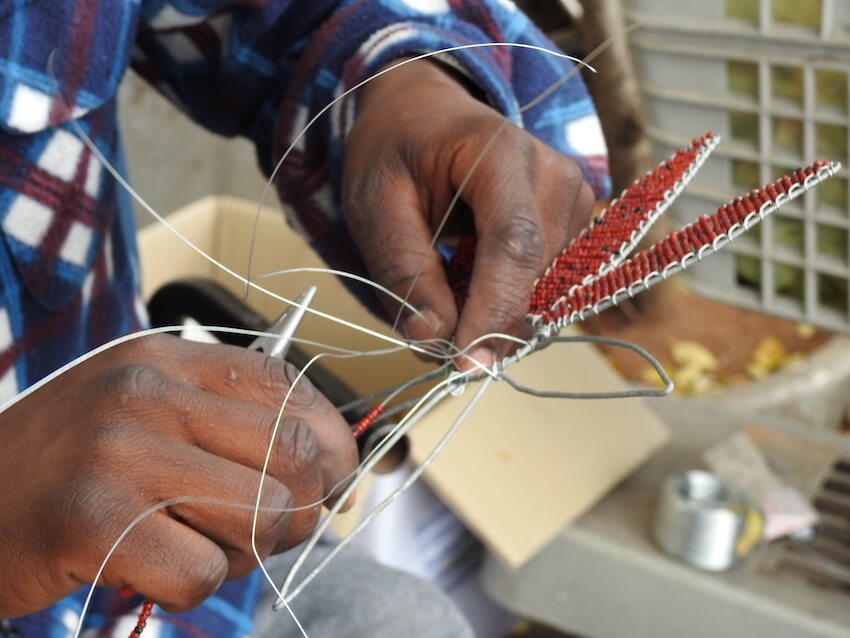 He lives in Hillbrow, and sells enough to a decent living. But his earnings have to cover the rent for a store room so his tools and finished items can be locked up safely every night. He has a trading permit to show the police, so they can’t harass him or confiscate his goods like they used to.
He lives in Hillbrow, and sells enough to a decent living. But his earnings have to cover the rent for a store room so his tools and finished items can be locked up safely every night. He has a trading permit to show the police, so they can’t harass him or confiscate his goods like they used to.
Chisvo knows many other beaders, sometimes visiting them to look for new ideas, or to tell them about something that’s selling well on his patch. “We help each other out. Most of them are from Zimbabwe - they’re home boys,” he says.
His work costs from R85 to a couple of thousand, and you can haggle, of course. But his wide grin and friendly eyes will probably charm you into offering more than he’s actually asking for.